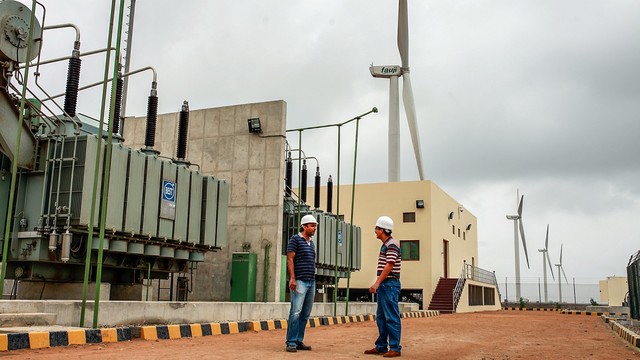Rethinking rural electrification: are cooperatives best for delivery?
With rural electrification rates still stubbornly low across sub-Saharan Africa, the world is not on track to deliver the UN Sustainable Development Goal (SDG7) of universal affordable and cleaner electricity by 2030. Could electric cooperatives be the answer?


In its 2023 Energy Progress Report (PDF), the International Renewable Energy Agency (IRENA) estimates that 675 million people have no access to electricity, and 80% of these folks live in rural areas.
With recent setbacks in expanding access highlighting the challenges of delivering SDG7, the report warns that achieving universal access this decade remains unlikely, and some 660 million people are expected to remain without access by 2030. And while access to electricity alone will not bring households out of poverty, it is crucial for promoting economic growth and opportunity.
A move towards mini-grids
That is why electricity access is at the forefront of many sub-Saharan African governments’ economic plans, with a focus on expanding large, centralised grids.
But with 37 out of 39 public electric utilities in the region unable to balance revenue with expenses, their cascading losses are a disincentive to further grid expansion, especially in rural areas where households have limited ability to pay.
As an alternative, many donors and investors in the global North have favoured mini-grids – decentralised systems that can power hundreds or thousands of households and businesses. But the World Bank estimates that connecting 490 million people by 2030 will require 217,000 mini-grids (up from the existing 21,500) and cost about US$127 billion.
Power for all, not the few
The energy access narrative over the last decade has focused on companies as being uniquely positioned to deliver SDG7. And while private financing can enable innovative delivery models in decentralised renewable energy systems, insufficient risk-adjusted returns pose a challenge for investors, and governments continue to prop up failing national utilities facing quasi-fiscal deficits, effectively subsidising grids.
This further inhibits progress towards SDG7, as achieving universal access requires providing power wherever necessary, not only where it is lucrative.
Rural electric cooperatives
Yet sustainable rural electrification in the global South has never relied exclusively on private sector actors. In countries such as Bangladesh, the Philippines and Costa Rica, mini-grids and power utilities operated by rural electric cooperatives have offered a successful alternative model for rural electrification.
An electric cooperative is owned by its members – also the end users – and rooted in the seven internationally recognised cooperative principles, reflecting the values of equality, democracy, self-help, mutual aid, and solidarity.
Although the cooperative model has not been deployed at scale in the mini-grid setting, early results in Liberia and Uganda show that it can be successful in rural areas, where electrification is more challenging and less profitable due to the smaller number of end users and lower population densities.
Examples from the US and Liberia
During the Great Depression in the 1930s, rural electrification in the US was around 10% and the low profit margins prevented investor-owned electric utilities from extending service into rural areas. In response, rural farmers formed electric cooperatives.
In 1936, the US government formed the Rural Electrification Administration to help deliver rural electrification via standardisation and other efficiencies, while supporting the establishment of these cooperatives. Crucially, it provided them with concessional, 30-year loans and extended credit to households to wire their homes and buy electric appliances to stimulate demand.
By 1953, more than 90% of US farms had electricity, using an electrification model that delivered electricity at 59% of the cost estimated by private utilities.
In sub-Saharan Africa, the region most lagging on SDG7, public sector financing has historically been inaccessible for electric cooperatives. But the Totota Electric Cooperative, Liberia’s first licensed electric cooperative established in 2018 with support from USAID, has achieved economic self-sufficiency, doubled its members in five years, tripled peak demand, and empowered widespread rural economic development.
Putting people over profit
Mini-grid developers in sub-Saharan Africa today face challenges in reaching scale, as they need to standardise, aggregate projects, streamline construction and reduce costs. The World Bank also notes that community-based cooperatives may lack the skills needed to manage mini-grid infrastructure.
But as demonstrated in Liberia, the US, Latin America and Southeast Asia, these challenges can be overcome.
Electric cooperatives prioritise people over profit. They are owned by their members and led by democratically elected leaders. And rather than export profits to international investors, they reinvest economic surplus into the cooperative or distribute it to members, providing an alternative to the historical extractive model linked to historical systems of oppression.
Empowering communities through reliable, sustainable power
History has shown that electric cooperatives are a proven pathway to universal energy access and can be a vital delivery model for achieving SDG7. And although – as with for-profit mini-grid developers – they will not work in every context, it is important to consider them as a preferred model in any electrification toolkit.
Donors and investors have an opportunity to enable more meaningful impacts by giving mini-grids owned and operated by electric cooperatives the same kind of support that has been proven to work elsewhere: patient capital, technical assistance, building on existing agricultural cooperatives and so on.
This autonomous model can lay the foundations to ensure communities have access to reliable power, contributing to economic growth and creating a new generation of rural leaders, while forging a clear path to a ‘just transition’.
With thanks to Zuraidah Hoffman for their contributions to this blog.



